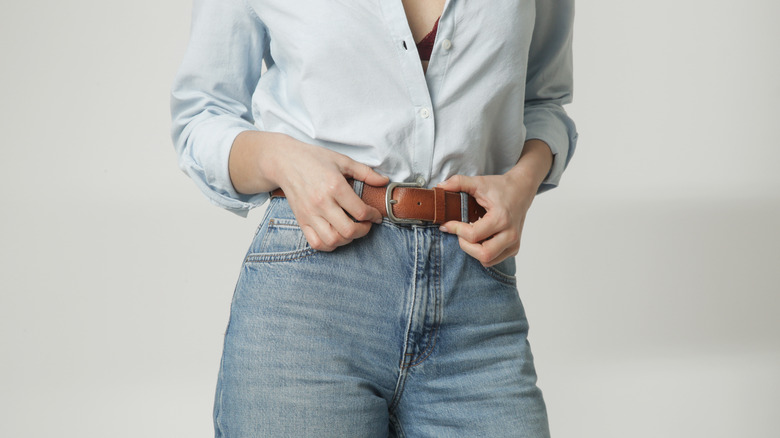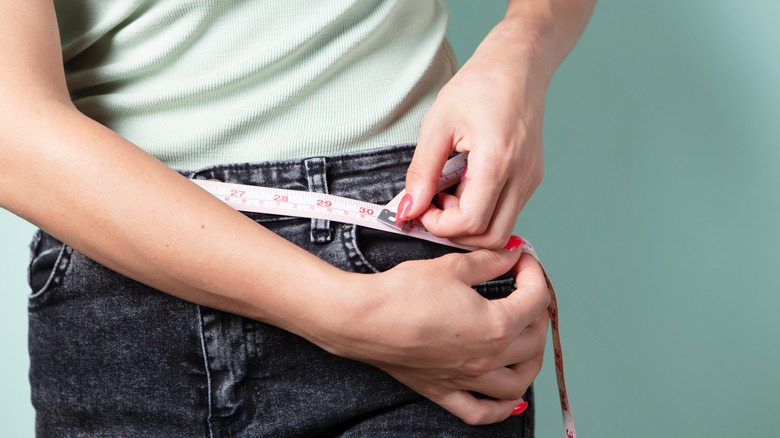Figuring Out What Size Belt To Wear Is Easier Than You Think
Belts are a handy accessory to have in your wardrobe. Whether you decide to wear them with your favorite pair of jeans or add them to a long maxi dress during summer, belts have a great way of bringing a look together. Not to mention that there is so much variety to choose from — leather belts, clinch belts, braided belts, belts made of chain, studded belts, canvas, etc.
With the various ways to style belts, however, comes the problem of perfect sizing. If you have ever been belt shopping before, you may have noticed the sizes printed on the back of the belts. They could be either in European sizing, which is displayed in centimeters, or in U.S. sizing, featured in inches. It's important to understand what a belt size actually is before you find one that fits you. As explained by belt maker Joe Meling on YouTube, "When we measure a belt, we're going to be measuring from the fold, where the buckle attaches, down to the center hole." The buckle isn't included in the typical measurement of a belt.
Usually, belts have five holes in them, and the center hole is where you should be wearing your belt. The other holes are there for a better fit when you either gain or lose weight. Now that you understand belt sizes, it's time to figure out how to find the right size for you. It's a lot easier than you think.
Try the pant size method
Using your pant size to figure out what belt size you should wear is probably one of the most convenient hacks out there. It's easy and quick, especially for those times when you don't have a measuring tape around or you're trying to surprise your best friend with a belt for Christmas and all you have at hand is their pant size.
The rule to follow here is to add two inches to your regular pant size. For example, if you're a pant size 32, go for a belt size of 34. Fashion influencer @brokebouijebabe added in a TikTok post that this sizing could change, however, depending on whether you decide to wear the belt over a coat. "If you plan to wear something thick, like an overcoat, a dress, [or] a sweater, then you probably want to size up a little bit more accordingly to what you plan to wear, but bigger is always better," she said.
But although the pant size method is convenient, Joe Meling wouldn't recommend it as the most accurate measurement, mainly because there are so many different kinds of jeans on the market now. While some sit high on your waist, others ride low near your hips. So the "add two inches" rule might be best used if you're looking for a belt to wear with a regular jean fit — something that sits on your waist.
Take out that measuring tape
If you want the best measurement of your waist, getting the help of a soft measuring tape (or even a piece of thread that can be later measured against a cased tape measure) would be the way to go.
Pull on your favorite pair of jeans, and thread the measuring tape through the loops as you would a belt, as Joe Meling shared on YouTube. Avoid roughly measuring your waist while wearing a dress or a lumpy sweater, as this is going to throw off accuracy. Now, to make space for the buckle (which is not usually included in the belt size, as mentioned previously), subtract about one inch, and that will be accurate enough, according to Meling. "You would take your waist measurement minus one inch. Now, when you do that, the idea is to land somebody in the center hole," he explained.
The third and final way to figure out what belt size you should wear is to take the measuring tape to an existing belt you have and love. Lay the belt out on a flat surface, and measure the length from the fold (avoiding the buckle) right down to the hole you usually use. Convert the measurement, if necessary, using a size chart, and voila, you have the right belt size for you. Now that you know all about sizing, it's time to shop for your favorite cincture, especially since belts are going to be everywhere this season.

